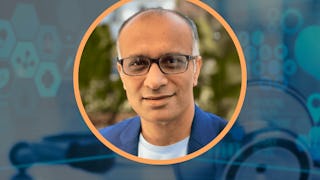Clinicians and healthcare professionals are increasingly burdened by Electronic Health Records (EHRs)—navigating complex interfaces, documenting care manually, and missing key insights in siloed data. Generative AI offers a practical path forward. This course shows you how to integrate GenAI tools into your EHR workflows to reduce documentation time, streamline operations, and improve patient care—without waiting on your EHR vendor.


您将学到什么
Explain key EHR challenges and how GenAI can improve clinical and operational workflows
Apply GenAI tools to streamline documentation and automate routine healthcare tasks.
Identify GenAI use cases that enhance patient education, coding, and clinical analytics.
Optimize GenAI implementation through effective governance, integration, and performance monitoring.
您将获得的技能
- Revenue Cycle Management
- Real Time Data
- Patient Education and Support
- Electronic Medical Record
- Automation
- Simple Object Access Protocol (SOAP)
- Smart Goals
- Healthcare Industry Knowledge
- Data Governance
- Medical Billing and Coding
- Patient Communication
- Generative AI Agents
- AI Personalization
- Clinical Documentation
- Business Process Automation
- No-Code Development
- Health Informatics
- Responsible AI
- Health Information Management and Medical Records
要了解的详细信息
了解顶级公司的员工如何掌握热门技能

该课程共有6个模块
In this course, you’ll learn how to transform Electronic Health Records (EHR) workflows with Generative AI by automating clinical documentation, enhancing patient communication, and streamlining healthcare operations. You’ll focus on real-world practices such as voice-to-SOAP note transcription, AI-powered patient education, and no-code workflow design with tools like Glass Health, DoraScribe, and Keragon. Through expert instruction, case studies, and hands-on exercises, you’ll gain the skills to reduce documentation time, build scalable AI assistants, and implement governance strategies that ensure safe and effective AI adoption in clinical settings.
涵盖的内容
1篇阅读材料
In this module, you’ll explore why Electronic Health Records (EHRs) need Generative AI support, how leading vendors like Epic, Cerner, and Meditech are embedding AI into workflows, and what it takes to get ready for adoption. You’ll break down common EHR pain points, examine practical AI use cases, and practice foundational prompt engineering. Through expert insights, real-world case studies, and a readiness self-assessment, you’ll gain the skills to evaluate your own environment, build awareness, and set realistic expectations for integrating GenAI into healthcare documentation and operations.
涵盖的内容
10个视频1篇阅读材料1个作业1次同伴评审1个讨论话题
In this module, you'll learn how to enhance Electronic Health Record (EHR) documentation and workflow efficiency using Gen AI tools. Through practical demos and exercises, you’ll streamline clinical documentation, automate repetitive tasks, and improve patient-facing content. You will explore tools for structured clinical documentation, ambient scribing, and voice-to-text solutions, enabling you to create accurate and concise clinical notes in real time. The module emphasizes usability, speed, and improving the quality of documentation across healthcare roles, from clinicians to administrators.
涵盖的内容
10个视频1篇阅读材料1个作业1次同伴评审1个讨论话题
In this module, you’ll discover how GenAI can transform patient education, revenue cycle management (RCM), and clinical analytics using EHR data. Through hands-on demos and practical exercises, you’ll learn how to use AI tools to create personalized patient narratives, automate billing and coding, and build no-code dashboards to extract actionable insights. The module focuses on enhancing communication, improving operational efficiency, and applying predictive analytics to drive better decision-making in healthcare.
涵盖的内容
10个视频1篇阅读材料1个作业1次同伴评审1个讨论话题
In this module, you’ll gain the knowledge needed to successfully implement and scale GenAI tools alongside Electronic Health Records (EHRs). The focus is on governance, integration, and post-deployment evaluation. You’ll learn about key governance frameworks, bias mitigation strategies, and how to integrate GenAI with EHR systems using standards like SMART-on-FHIR. The module also covers the essential processes for monitoring AI performance and continuous improvement, ensuring a safe, ethical, and sustainable GenAI adoption in your organization.
涵盖的内容
10个视频1篇阅读材料1个作业1次同伴评审1个讨论话题
In this final module, you will synthesize your learning from the entire course and apply it to a real-world challenge involving EHR workflows. You’ll design a GenAI-powered assistant to address documentation, operational, or patient-facing issues. Through this project, you’ll demonstrate your ability to integrate GenAI tools into healthcare workflows while considering governance, risk mitigation, and implementation strategies. This module culminates in a project that showcases your ability to enhance EHR usability, efficiency, and care quality with AI-driven solutions.
涵盖的内容
1个视频1次同伴评审
提供方
从 Health Informatics 浏览更多内容
 状态:免费试用
状态:免费试用 状态:免费试用
状态:免费试用Coursera
 状态:免费试用
状态:免费试用Coursera
 状态:免费试用
状态:免费试用Coursera
人们为什么选择 Coursera 来帮助自己实现职业发展




常见问题
To access the course materials, assignments and to earn a Certificate, you will need to purchase the Certificate experience when you enroll in a course. You can try a Free Trial instead, or apply for Financial Aid. The course may offer 'Full Course, No Certificate' instead. This option lets you see all course materials, submit required assessments, and get a final grade. This also means that you will not be able to purchase a Certificate experience.
When you purchase a Certificate you get access to all course materials, including graded assignments. Upon completing the course, your electronic Certificate will be added to your Accomplishments page - from there, you can print your Certificate or add it to your LinkedIn profile.
Yes. In select learning programs, you can apply for financial aid or a scholarship if you can’t afford the enrollment fee. If fin aid or scholarship is available for your learning program selection, you’ll find a link to apply on the description page.
更多问题
提供助学金,
¹ 本课程的部分作业采用 AI 评分。对于这些作业,将根据 Coursera 隐私声明使用您的数据。






